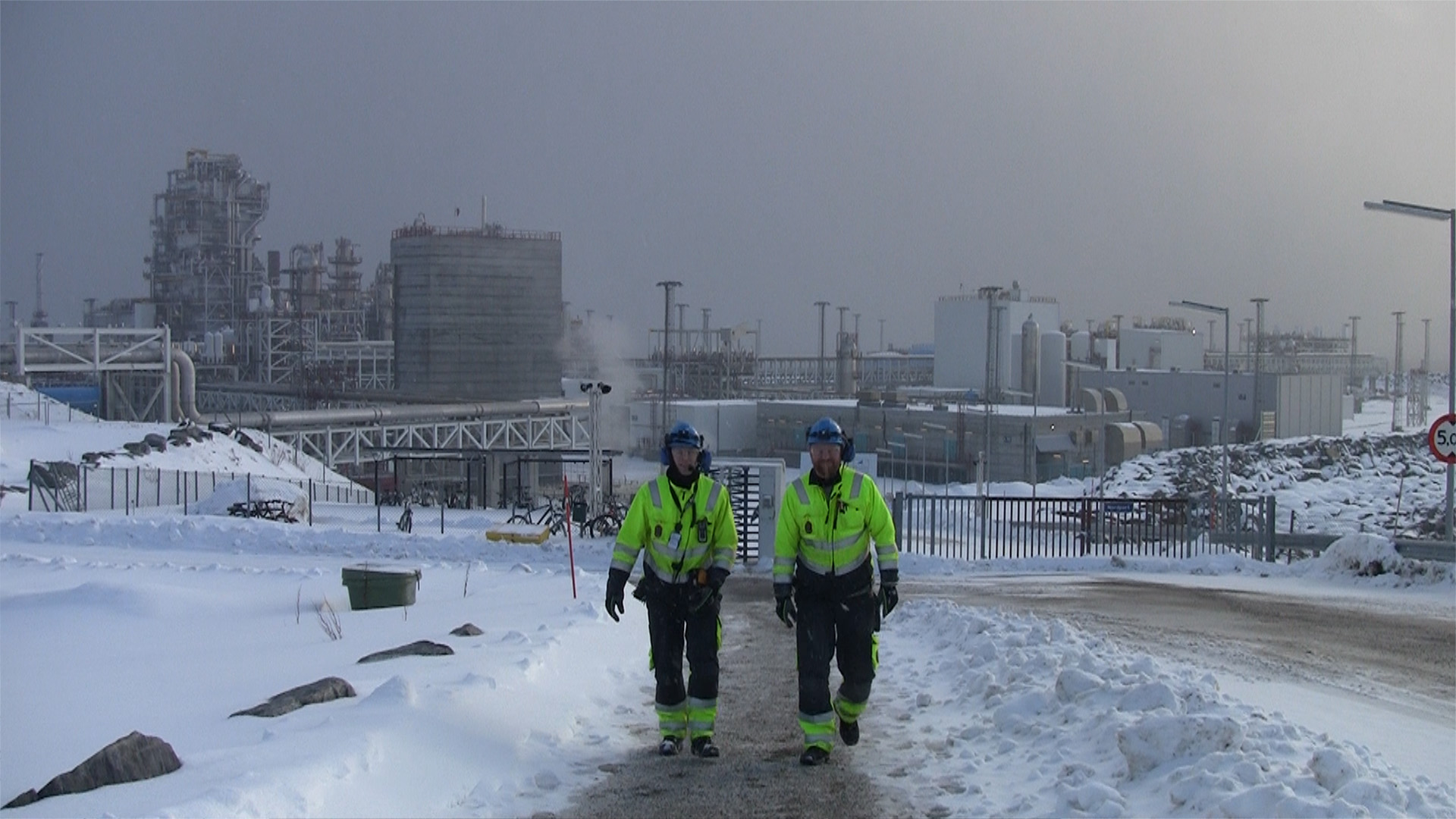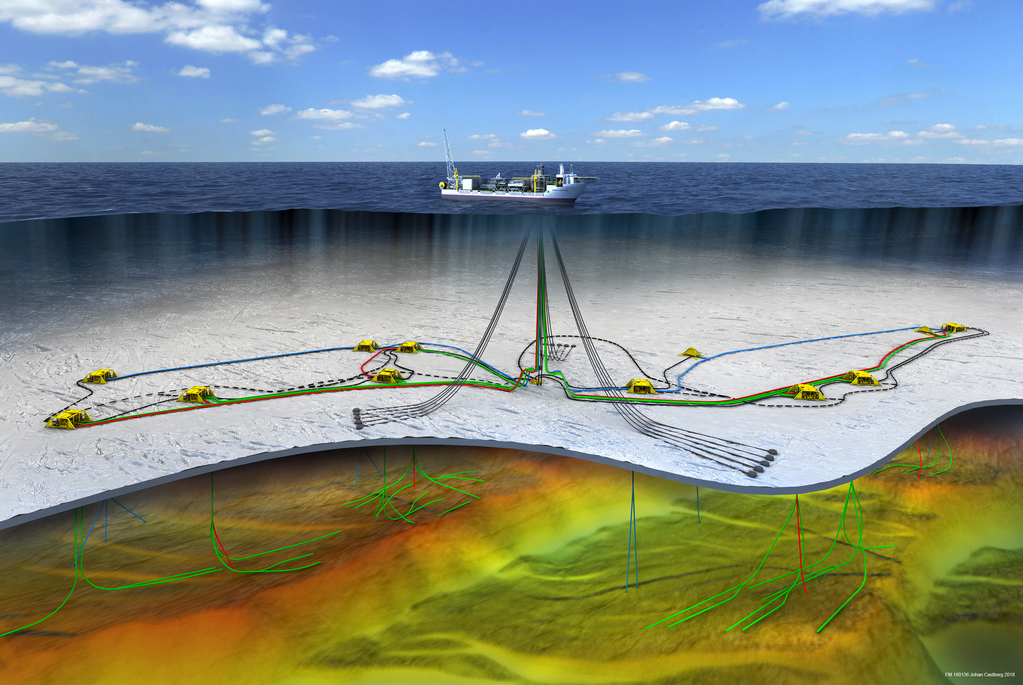The future is in the north

The Snøhvit gas is cooled into liquid form at the Melkøya facility. Working here is rough due to hard weather conditions in northern Norway. Photo: Martha Steensnæs.
5/8/2019 Our estimates indicate that more than half of the oil and gas that has not yet been discovered is located in the Barents Sea. The rest is distributed between the Norwegian Sea and the North Sea. The opportunities are greatest in the Barents Sea, where vast areas have not yet been explored.
The numbers tell us that the opportunities on the Norwegian Shelf are still significant, and this provides a basis for oil and gas production for many decades to come.
Two fields are currently producing in the Barents Sea, Snøhvit and Goliat. Goliat was proven in 2000, and production started 16 years later. The oil from Goliat is transported from the field by boat.
At that time, the Snøhvit gas field (proven in 1981) was already in operation. The gas from Snøhvit is routed by pipeline to Melkøya outside Hammerfest, where it is cooled into liquid form (LNG, liquefied natural gas).
Meet vice president Hammerfest LNG Operations and maintenance, Andreas Sandvik:
Principle engineer Kim Johnsen explains the Melkøya CCS:
The Norwegian Petroleum Directorate presented the report titled Petroleum activity in the High North on 2 April (in Norwegian only). The report places the petroleum activity in the High North into a historical, international and technological framework.
”We hope that the report can contribute in a knowledge-based approach to the debate,” said director general Bente Nyland when she presented the report at the Barents Sea Conference 2019.
Equinor and partners Petoro, Total, Neptune and DEA are already planning for the future. The first thing that will happen is that the Askeladd deposit in the Snøhvit licence will commence production.
Mr Sandvik explains:
Chemical process apprentice Sverre Rogde says he has the world’s best job:
Goliat is the only producing oil field in the Barents Sea and is operated by Vår Energi.
Vice president Operations Rune Oldervoll explains:
Plans for the coming years:
In late 2018/early 2019 Vår Energi and its partners drilled appraisal well 7122/7-7 S on the Goliat field. It proved oil, and the companies are now looking at the possibility of producing oil from the Goliat facility.
The Alke (7120/12-2) gas and condensate discovery, which was proven in 1981, is operated by Vår Energi. In May 2017, planning for a potential development of this discovery was resumed, and several potential development solutions are being considered.
Johan Castberg is up next
The next field development in the Barents Sea is Johan Castberg.

The Plan for Development and Operation (PDO) for the Johan Castberg oil field was approved in June 2018. According to the plan, the field will start producing in late 2022.
The development concept is a production and storage ship (FPSO) tied to subsea templates with 18 horizontal production wells and 12 injection wells. The oil will be loaded onto shuttle tankers that will transport it to the market.
Facts about oil and gas in the Barents Sea
- In 1979, a limited area was opened for petroleum activity in the Barents Sea, 20 blocks on Tromsøflaket (5th licensing round on the Norwegian Shelf).
- The first exploration well, (7120/12-1) was drilled in 1980.
- The first discovery, 7120/78-1 Askeladd, was made in 1981. This is now part of the Snøhvit field.
- Up to the end of March 2019, 155 exploration wells had been spudded (wildcat and appraisal wells).
- Over the course of the years from 1980 to April 2019, 59 discoveries have been made in the Barents Sea.
- Two fields are currently producing in the Norwegian part of the Barents Sea; the Snøhvit gas field (discovered in 1984) and the Goliat oil field (2000).
- The Johan Castberg field is under development, and the plan is for the field to start producing in 2022.
- As of today, the total undiscovered resources on the Norwegian Shelf are estimated at 4 billion standard cubic metres of oil equivalents. More than half of these resources are located in the Barents Sea.
- The licensees (the companies) are responsible for exploring, developing and operating oil and gas fields, and they are the ones that must deal with the challenges associated with operating petroleum activities in the north.
- Challenges can include low air and sea temperatures, icing, long distances and limited infrastructure.
- The Gulf Stream ensures that the Norwegian part of the Barents Sea has little or no sea ice, and sea ice only occurs during parts of the year.
- As of 1 April 2019, there are 77 production licences in the Barents Sea (211 blocks/parts of blocks), and they cover 49 000 square kilometres.
- Exploration on the Norwegian Shelf is profitable, also in the Barents Sea. The Norwegian Petroleum Directorate’s resource report for exploration (2018) shows that every 1000 kroner invested in exploration in the Barents Sea has given 2100 kroner in return.
Photo: Equinor and Vår Energi
Text and video recording: Bente Bergøy and Martha Steensnæs
Video editing: Øystein Leiknes Nag
Updated: 5/8/2019